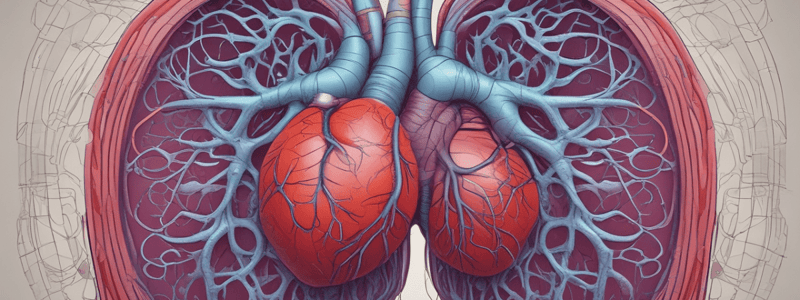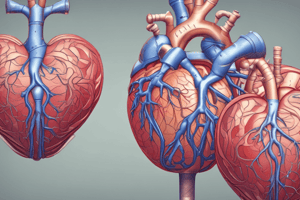Podcast
Questions and Answers
What is the name of the valve that separates the right atrium and ventricle?
What is the name of the valve that separates the right atrium and ventricle?
- Mitral valve
- Pulmonary valve
- Tricuspid valve (correct)
- Aortic valve
Which of the following veins drains into the right atrium?
Which of the following veins drains into the right atrium?
- Aorta
- Superior vena cava (correct)
- Pulmonary vein
- Inferior vena cava (correct)
What is the function of the mitral valve?
What is the function of the mitral valve?
- Separates the left atrium and ventricle (correct)
- Prevents backflow from the aorta into the left ventricle
- Allows blood to flow from the pulmonary artery to the pulmonary vein
- Separates the right atrium and ventricle
How many chambers does the heart have?
How many chambers does the heart have?
What is the term for the valves that separate the atria and ventricles?
What is the term for the valves that separate the atria and ventricles?
What is the name of the artery that arises from the left ventricle?
What is the name of the artery that arises from the left ventricle?
In which chamber of the heart does the pulmonary vein drain?
In which chamber of the heart does the pulmonary vein drain?
What is the term for the valves that are located at the base of the pulmonary artery and aorta?
What is the term for the valves that are located at the base of the pulmonary artery and aorta?
What is the most sensitive and specific test for myocardial damage?
What is the most sensitive and specific test for myocardial damage?
What is the condition that may develop after myocardial infarction, leading to thrombus formation?
What is the condition that may develop after myocardial infarction, leading to thrombus formation?
What is the consequence of papillary muscles rupture after myocardial infarction?
What is the consequence of papillary muscles rupture after myocardial infarction?
What is the peak time for Creatine Kinase (CK-MB) test?
What is the peak time for Creatine Kinase (CK-MB) test?
What is a false aneurysm?
What is a false aneurysm?
What is the name of the node that generates an electrical impulse 1-2 times per second in the heart?
What is the name of the node that generates an electrical impulse 1-2 times per second in the heart?
What is the term for a 'leaky valve' in the heart?
What is the term for a 'leaky valve' in the heart?
What is the purpose of the coronary arteries?
What is the purpose of the coronary arteries?
What is the result of the coronary arteries becoming significantly blocked?
What is the result of the coronary arteries becoming significantly blocked?
How many atrio-ventricular valves are there in the heart?
How many atrio-ventricular valves are there in the heart?
What is the term for the accumulation of fats, cells, and calcium on the inner walls of arteries?
What is the term for the accumulation of fats, cells, and calcium on the inner walls of arteries?
What is the electrical pathway in the heart that follows the AV node?
What is the electrical pathway in the heart that follows the AV node?
What is the term for a 'tight valve' in the heart?
What is the term for a 'tight valve' in the heart?
Flashcards are hidden until you start studying
Study Notes
The Cardiovascular System: Heart Anatomy
- The heart is a hollow, muscular organ located in the mediastinum, inside the parietal pericardium.
- It has four chambers: right atrium, left atrium, right ventricle, and left ventricle.
- The heart has four valves: tricuspid, mitral, pulmonary, and aortic.
- The heart has two separate, but integrated pumps: right ventricle pumps into pulmonary circulation, and left ventricle pumps into systemic circulation.
Valves, Septa, and Chambers
- The tricuspid valve is located between the right atrium and ventricle.
- The mitral valve is located between the left atrium and ventricle.
- The pulmonary valve is located between the right ventricle and pulmonary artery.
- The aortic valve is located between the left ventricle and aorta.
Flow of Blood Through the Heart
- The flow of blood through the heart is: superior and inferior vena cavae → right atrium → tricuspid valve → right ventricle → pulmonary valve → pulmonary artery → pulmonary veins → left atrium → mitral valve → left ventricle → aortic valve → aorta.
Conduction System of the Heart
- The sino-atrial (SA) node is located in the superior wall of the right atrium and generates electrical impulses at a rate of 1-2 times per second.
- The electrical impulses travel through the atria, causing contraction, and then to the atrio-ventricular (AV) node.
- The AV node sends the electrical impulses to the AV bundle, which splits into the right and left bundle branches, and finally to the Purkinje fibers, causing ventricular contraction.
Intrinsic Regulation - Pacemaker
- The cardiac cycle consists of heart beats, atrial contraction, ventricular contraction, and relaxation.
- The SA node is the pacemaker of the heart, generating electrical impulses that regulate the heart rate.
Coronary Arteries and Heart Attack
- The coronary arteries supply oxygen to the heart muscles, which have a high oxygen demand.
- The coronary arteries are divided into two main branches: right and left.
- Atherosclerosis is a condition where fats, cells, and calcium accumulate on the inner walls of arteries, leading to ischemia, angina, and potentially myocardial infarction (heart attack).
Myocardial Infarction
- Myocardial infarction occurs when the coronary arteries become significantly blocked, leading to a lack of blood flow and death of heart muscle.
- The condition can lead to complications such as arrhythmias, left ventricular failure, cardiogenic shock, rupture, and thromboembolism.
- Cardiac enzymes such as troponin, creatine kinase (CK-MB), and lactate dehydrogenase (LDH) can be used to diagnose myocardial infarction.
Studying That Suits You
Use AI to generate personalized quizzes and flashcards to suit your learning preferences.




